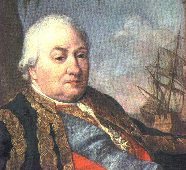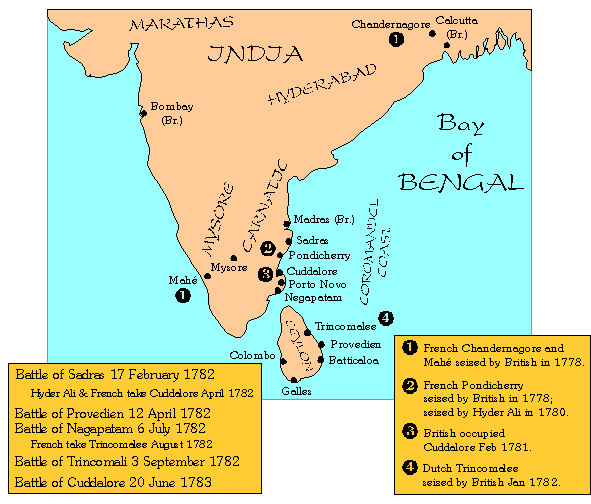SUFFREN'S EAST INDIAN CAMPAIGN (1782-1783)
IN THE
AMERICAN WAR FOR INDEPENDENCE
Or to say in another way:
THE LAST BATTLES of the AMERICAN REVOLUTION
fought on the OTHER SIDE of the WORLD
|
|
|
|
LE BAILLI DE SUFFREN

Admiral Pierre-André de Suffren Saint-Tropez, called 'Bailli de Suffren', (1729-1788).
Oil painting by Pompeo Batoni (c.1785). Held by Musée National du Château de Versailles et de Trianon. Suffren went by the Maltese Order title of Bailli. He was a member of Ordre des Chevaliers de Malte, and had served (1749-54) in the Order's navy between his regular service in the Marine Royale.
|
The war for American independence was fought elsewhere than on, or in, the waters off the North American continent. Probably the last formal engagements were fought on the other side of the globe and had no American present. These were part of a naval campaign that received significant notice in A.T. Mahan's The Influence of Sea Power Upon History (1660-1783) as he assess Suffren's "brilliant" naval campaigns in the Indian Seas, 1782 and 1783. More than one historian has defined André de Suffren as France's finest admiral of the era.
Chevalier-commander André de Suffren, a well experienced seaman, led a French naval squadron out of Brest at the same time De Grasse's larger fleet deployed to North America in 1781. Suffren's squadron headed toward the Indian Ocean. Enroute, he surprised and seriously damaged an English naval squadron at La Praya in the Cape Verde Islands (16 April 1781). Suffren then went to the Dutch colony at the Cape of Good Hope and off loaded French troops to aid in the defense. Proceeding east, around the Cape, Suffren joined with another French squadron at Île de France [Mauritius], a major French port in the Indian Ocean. The French fleet proceeded east to the Bay of Bengal, where Suffren would for nearly two years maneuver and fight against much better provisioned British naval formations. Suffren's only shore assistance was from the Indian Mysore leader, Hyder Ali, who was also fighting the British, and use of small Dutch ports in Ceylon.
|
|

|
|
|

|
- 17 February 1782
- Suffren (12 ships), confronted Admiral Edward Hughes' British squadron (9 ships) off Madras (on the Coromandel Coast of India) in the 'Battle of Sadras'. [Sadras is a small town south of Madras, the major British-held port. Some refer to this battle as that of 'Madras'.] Though neither side lost a ship, the mutually inflicted damage to their squadrons caused both naval commanders not to continue the engagment the following day. Hughes headed for Trincomlee (northeast coast of Ceylon) for repairs. Suffren went to Pondicherry (immediately south of Sadras), which had been recently retaken from the British by Hyder Ali. Suffren quickly made repairs, and in March continued on his mission to deliver French troops south of Porto Novo, a small town south of the British-held port of Cuddalore. The French captured Cuddalore on 4 April.
- 12 April 1782
- This battle occured off the small island of Providien, south of Trincomalee.
The engagement was essentially indecisive, and again both commanders did not find their respective squadrons prepared to continue the engagement. Hughes' squadron had some major damages and returned to Trincomalee. Suffren had no port facility in the region to support his squadron. However, he was able to make use of small harbor towns in southern Ceylon, which was all Dutch except for Trincomalee. Suffren anchored at Batticaloa and receive some supplies that arrived at nearby Point de Galles. He also provisioned his force by capturing British ships that were enroute to Madras.
- 6 July 1782
- Hughes (operating from Trincomalee) attacked Suffren, now operating from Cuddalore and attempting to take the costal port of Negapatam, further south on the Indian coast. A squall scattered the opposing ships, which broke off the action. The French suffered nearly twice the personal casualties as did the British, forcing Suffren to return to Cuddalore. The British ships had been too damaged to follow up, and had to go to Madras for major repairs.
|
|

Naval battle of Negapatam (6 July 1782).
|
- 25-31 August 1782
- Operations shifted back to the east coast of Ceylon. After being re-supplied from a French convoy at Batticaloa [Batacalo], Suffren returned to attack the small British garrison at Trincomalee. Rushing past the shore batteries, Suffren landed troops 26 August. The British port surrendered the 31st. This surprise, joint action obtained Suffren an useful anchorage for his squadron in the region. Leaving a strong contingent to defend the port, Suffren deployed his squadron outside the harbor to await Hughes' challenge.
- 3 September 1782
- Hughes' squadron arrived off Trincomalee. It appeared that the British might not try to force the situation. Suffren eagerly initiated the attack. However, the French managed to get only a few ships close enough to exchange gunfire against the more orderly battle formation of the British. The fighting ended late in the day, with Suffren's flagship Héros being heavily damaged. Hughes had to widthdraw, leaving the French seizure of Trincomalee. Both British and French naval squadrons retired from the east Indian coastal waters in October for the duration of the monsoon season and winter, Hughes to Bombay (west coast of India) and Suffren to Achin (northwest Dutch Sumatra, on the eastern side of the Bay of Bengal).
- 13-20 June 1783
- The British and French squadrons had been reinforced by early spring, Suffren (now 15 ships) Hughes (reinforced and now 18 ships), before returning to the Indian Coromandel Coast in 1783. In June, an English land force besieged the French at Cuddalore. Hughes' squadron provided support. Suffren managed to slip past Hughes' squadron and get into the roadstead on the 17th, where he obtained soldiers to offset his shortage of gun crews. On the 20th, Suffren set out from the Cuddalore harbor and engaged the British in a battle that lasted for two-and-a-half hours, terminated by night fall. The British squadron withdrew the following day due to shortage of water and considerable scurvy aboard their ships.
An interesting side note in this battle is that Suffren commanded from the frigate Cl�op�tre. Influenced by the capture of de Grasse's at the battle of the Saintes (12 April 1782), the French naval ministry sent out an order that, in battle, the flag officer commanding should direct his fleet from a frigate.
- 29 June 1783
- Suffren received word (evidently by way of Hughes) from Paris that hostilities were to end, and that preliminary articles of peace had been signed. There is no doubt that he contributed considerably to the British wanting to end the war. India and some other places in the world were not worth risking just to oppose the Americans' independence.

Admiral Suffren meeting with Hyder Ali, his ally and leader of the Mysore revolt against British rule in India. Color engraving by J.B. Morret, Bibliothèque Nationale
|
|
|
Return to the top of this page.
Return to webpage on 'French Naval Leaders and the French Navy in the American War for Independence'.
|

|
Return to
Expédition Particulière
page.
|
|
This page was created 7 February 2004.
|





